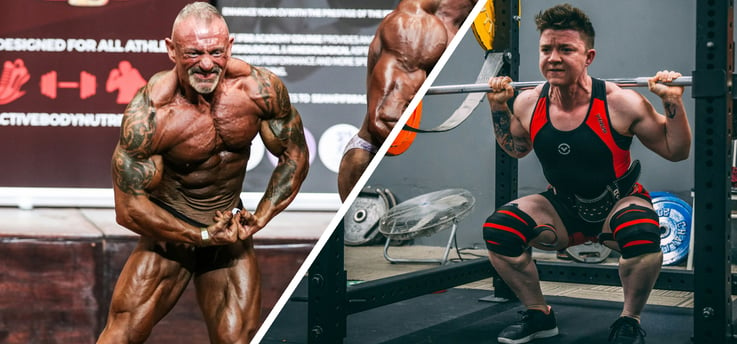Strength Training vs. Muscle Building: Key Differences and How To Get Maximum Gains
Learn what are the key differences between strength training and muscle building in this comprehensive guide. Whether you're aiming to improve muscle size or enhance strength, this article covers everything you need to know about strength vs. hypertrophy training.
TRAINING


Many people often focus on either building muscle size (hypertrophy) or increasing strength. While both are crucial aspects of a well-rounded fitness routine, the methods and principles behind strength training and muscle-building (hypertrophy) differ significantly. Understanding these differences can help you tailor your workout regimen to better align with your goals, whether you aim to boost sheer strength or focus on muscle growth.
1. Understanding Strength Training
Strength training is primarily about improving your ability to lift heavier weights and generate more force. It’s often associated with powerlifting or sports that require maximum strength output. The primary goal is to increase your one-rep max (1RM), which represents the heaviest weight you can lift for a single repetition. Strength training programs focus on neurological adaptation, helping your body recruit more muscle fibers and improve coordination.
Key Principles of Strength Training:
Low Reps, Heavy Weights: Typically, strength training uses 3-5 sets of 3-6 reps at 75-90% of your 1RM. This low-rep range focuses on building maximum strength and power.
Long Rest Periods: Rest between sets can last anywhere from 2 to 5 minutes, giving your muscles enough time to recover for optimal performance on the next set.
Compound Movements: Exercises like deadlifts, squats, bench presses, and overhead presses are foundational for strength training because they engage multiple muscle groups simultaneously, allowing you to lift the heaviest loads.
The goal here isn’t muscle size but neurological improvements, helping your muscles fire more efficiently to generate maximum force. This is why strength training doesn’t necessarily lead to bulkier muscles but instead results in increased power output.
2. Understanding Muscle Building (Hypertrophy Training)
On the other hand, hypertrophy training focuses on increasing the size of your muscles by causing mechanical tension and metabolic stress within muscle fibers. While strength training is about lifting maximum weight, hypertrophy is centered on volume—moderate weights, higher reps, and shorter rest periods to build muscle mass.
Key Principles of Hypertrophy Training:
Moderate Weights, Higher Reps: Hypertrophy training usually involves 3-5 sets of 8-12 reps at 60-75% of your 1RM. This range is optimal for creating muscle damage, which stimulates growth as your muscles repair and rebuild larger.
Shorter Rest Periods: Rest between sets is shorter, around 30-90 seconds. This contributes to metabolic stress, which also promotes muscle growth.
Isolation Exercises: While compound lifts are still crucial, hypertrophy training incorporates more isolation movements like bicep curls, leg extensions, and tricep extensions to target specific muscle groups.
The objective in hypertrophy is to damage muscle fibers through consistent tension and volume, allowing them to grow back bigger and stronger during recovery.
3. The Science Behind Strength vs. Muscle Size
Strength training and hypertrophy training create different physiological adaptations:
Strength Training Adaptations: Strength training primarily improves the efficiency of the neuromuscular system. This means your nervous system and muscles work better together to lift heavier weights. While you may become stronger, this doesn’t necessarily result in visibly larger muscles, as strength training focuses more on force output than muscle size.
Hypertrophy Training Adaptations: Hypertrophy, or muscle growth, occurs when muscle fibers break down and repair themselves during recovery, resulting in larger muscle mass. The combination of mechanical tension, muscle damage, and metabolic stress from higher volume training leads to muscle growth. This process is highly linked to bodybuilding, where the goal is not only strength but visible muscle development.
4. Which Should You Prioritize: Strength or Muscle Size?
The choice between training for strength or size comes down to your specific fitness goals:
If your goal is to increase strength: Stick with strength training principles. Focus on lower-rep ranges with heavier weights and longer rest periods. Strength training is ideal for those looking to improve power and performance, such as athletes in sports like powerlifting or sprinting.
If your goal is to build muscle mass: Prioritize hypertrophy training. Use moderate weights with higher reps to maximize muscle breakdown and growth. This approach is commonly favored by bodybuilders or anyone looking to enhance their physical appearance by increasing muscle size.
While these two methods are distinct, they don’t need to be mutually exclusive. In fact, blending strength and hypertrophy training into a comprehensive program can yield the best results for both strength and muscle size.
5. Combining Strength and Hypertrophy Training
Many lifters find success by incorporating both strength and hypertrophy principles into their workout routine. Here’s how to combine both effectively:
Strength-First Approach: Start your workouts with compound lifts (squats, deadlifts, bench presses) that focus on building strength. Perform low reps with heavy weights to target maximum strength. Afterward, switch to hypertrophy-focused sets with moderate weights and higher reps. This hybrid approach allows you to build strength while also promoting muscle growth.
Periodization: Another effective method is periodization, where you dedicate certain phases of your training to strength and others to hypertrophy. For example, you could spend 4-6 weeks focusing on strength training with lower reps and heavier weights, followed by a 4-6 week hypertrophy phase using higher reps and more volume. This method keeps your body continually adapting, leading to both strength gains and muscle growth.
6. Rest and Recovery: The Overlooked Component
Whether you’re focusing on strength or size, recovery is just as important as the time you spend in the gym. Muscle growth and strength improvements happen during recovery, not during the workout itself. Ensure you’re getting enough sleep (7-9 hours per night) and allowing time for muscle repair between workouts. Overtraining can hinder both strength gains and muscle growth, so it’s critical to incorporate rest days into your routine.
Conclusion
When it comes to building strength and muscle, both training methods offer significant benefits. Strength training helps you lift heavier and improve your power output, while hypertrophy training focuses on increasing muscle size and volume. Your personal fitness goals will dictate which approach to prioritize, but incorporating both methods can lead to balanced and optimal results. Whether you’re aiming for sheer strength, a bigger physique, or a mix of both, understanding the differences between strength and hypertrophy training will allow you to create an effective workout plan that aligns with your goals.


